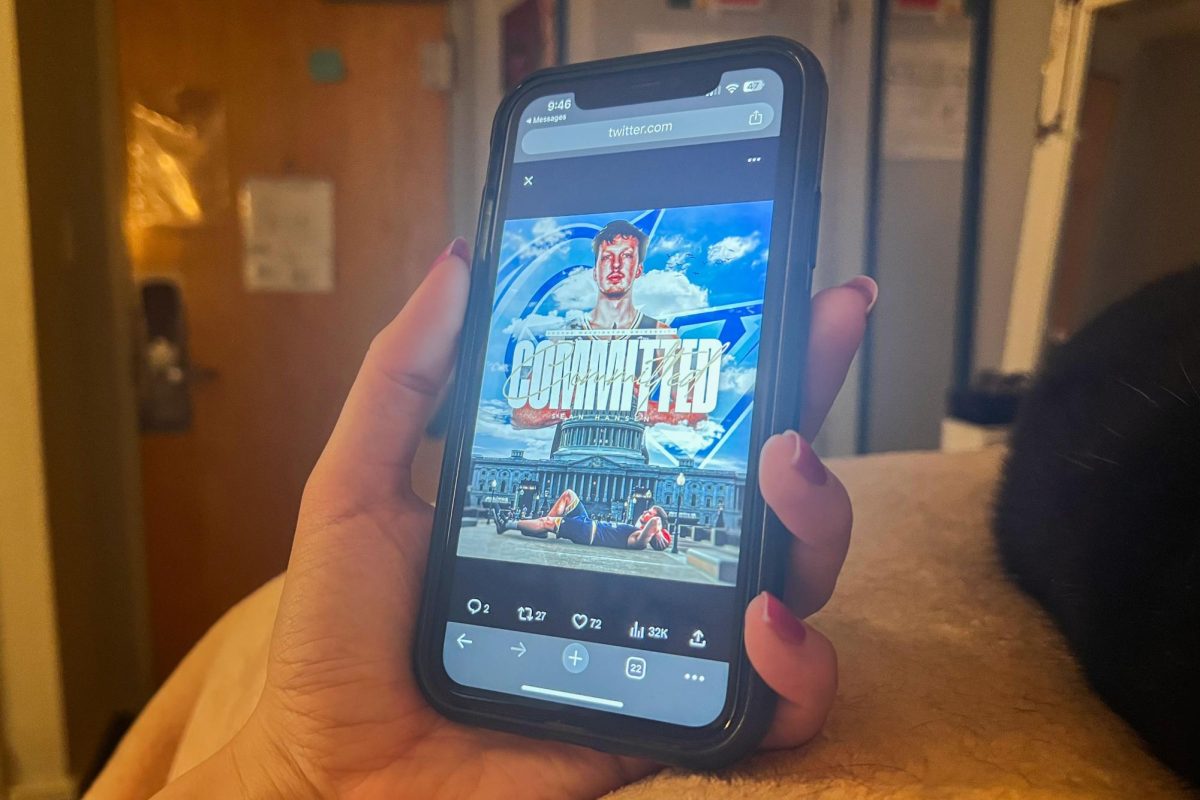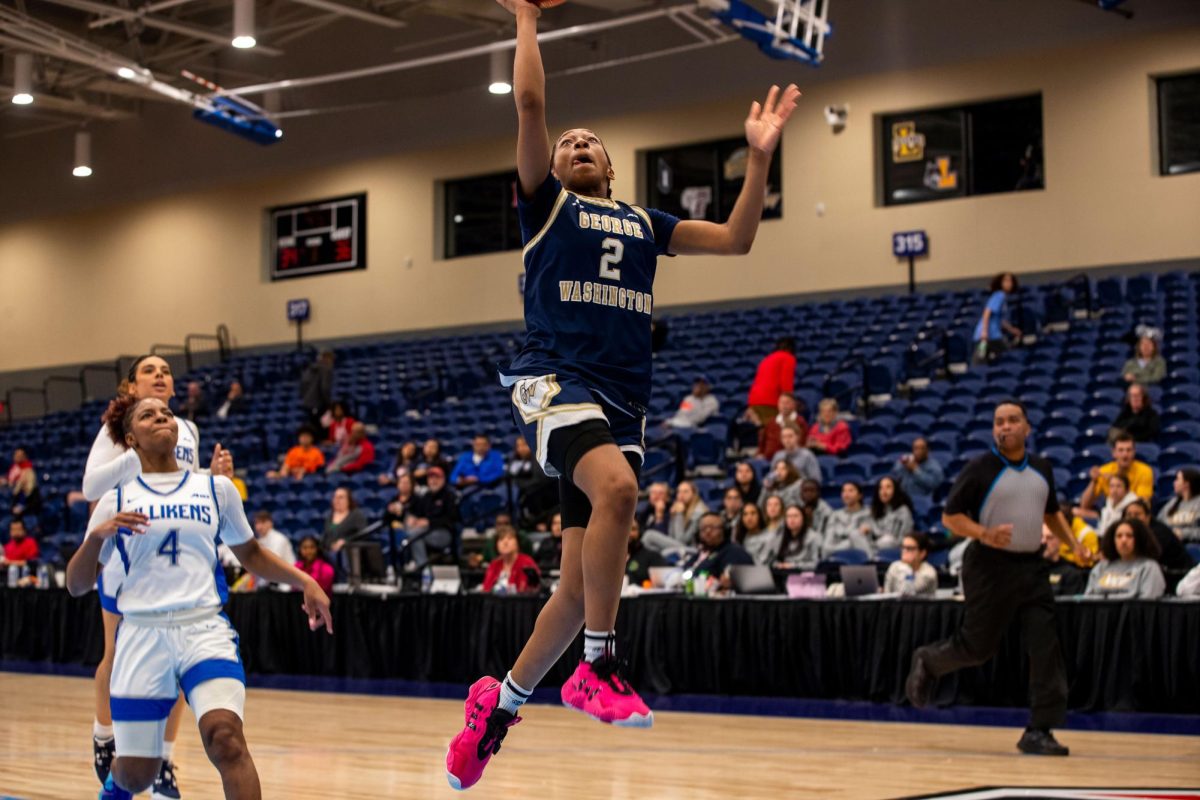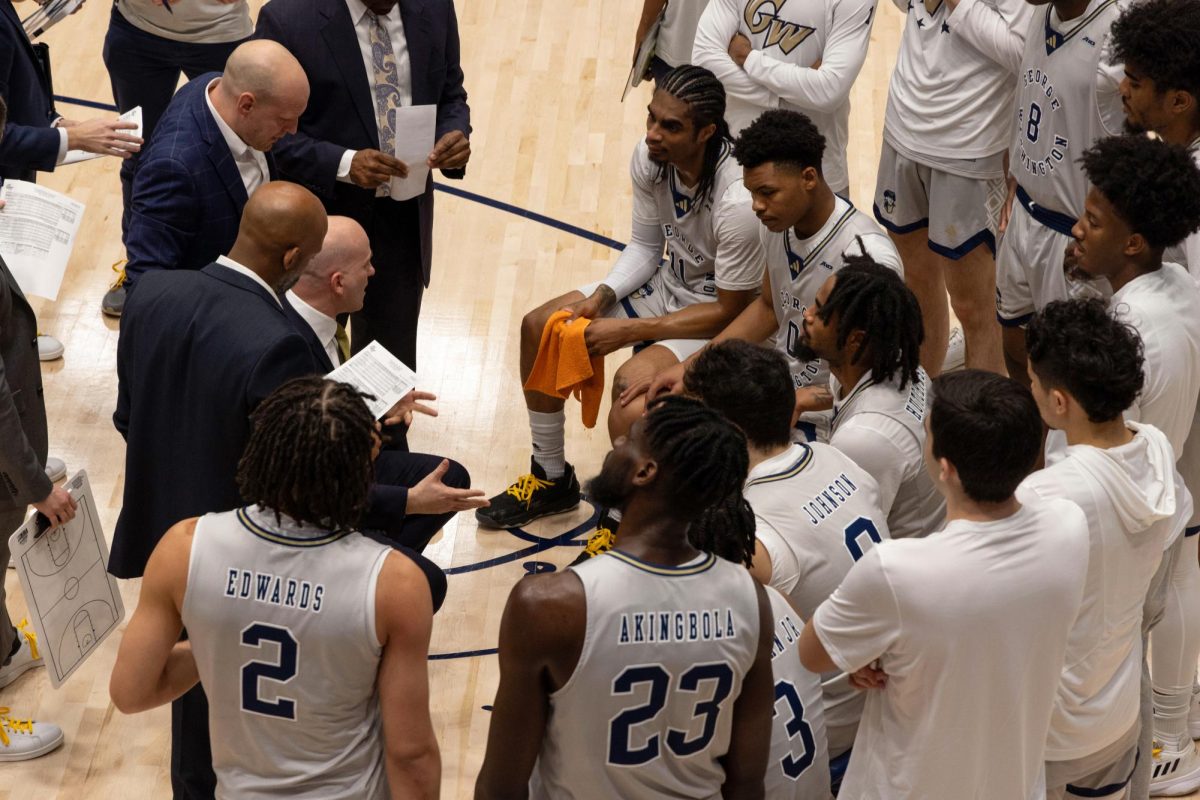The Hatchet sports section has been around almost as long as athletics at GW – since 1904, to be exact. And over the years, it has covered everything from the expansion of sports at GW, to the suspension of all sports at GW, to conference championships and even a recent scandal. But the section, which will celebrate the first of two “GW Hatchet Nights” at the Smith Center during Saturday’s men’s basketball game, had a humble beginning a century ago.
The first issue of the University Hatchet, printed Oct. 5, 1904, included a well-intentioned section called the “Athletic Outlook.” In it, sports editor James H. Price wrote with all the common familiarity of a barber talking sports with his customers.
“Of course,” Price wrote, “foot ball is the all-absorbing topic at the present time, although many of the base ball cranks are beginning to talk of the prospects of next spring.”
Archaic in style but goodhearted nonetheless, the concept of objectivity had not exactly been embraced in journalism around the turn of the century. But the casual, almost conversational style early editors used in writing shows how they viewed sports coverage in The Hatchet.
Price was right – football was the all-absorbing topic that dominated several pages of The Hatchet every week. A 2-by-6-inch ad on the sports page on Nov. 16, 1904, told students to “meet at GW at 2 o’clock and march in a body to Georgetown” for the football game. The editor even printed on a frequent basis the changes in collegiate football rules, until they were finalized on May 10, 1906.
In the Oct. 5, 1904, issue an article explained, “At least six men must be on the scrimmage line during play. The quarter may run with the ball at any time, provided he goes five yards to the side before advancing.”
For about a year after the first issue, there wasn’t a sport to cover besides football, baseball and the “tennis club.” In 1906, the paper started to regularly cover the track team, and the men’s basketball team shortly thereafter. Over the next 20 years, football would be the prime focus of Hatchet sports until the early 1930s, when men’s basketball became popular. Football remained an important part of The Hatchet’s sports coverage until it was discontinued in 1967 to finance the construction of the Smith Center.
The Hatchet and GW basketball
In 1906, men’s basketball started as an organized sport on the collegiate level, and a Hatchet editorial in the Dec. 13 issue of that year asked, “Why not basket ball? There is no reason why a strong basket ball team cannot be gathered from the quantity of good material at hand.” The piece suggested that the nucleus of players that was already scrimmaging regularly at the Y.M.C.A. “Get the game together and take steps toward getting out a team to represent the University.”
Nearly 40 years later, that team beat the College of William and Mary in the Southern Conference Tournament to win the 1943 conference title. “The situation was right for another upset,” read an article in the March 9 Hatchet that year. “But the Colonials … broke the jinx and scalped the troublesome Indians.”
Before the Smith Center, the basketball team practiced in the Tin Tabernacle, an old factory-turned-basketball court on H Street, and in places such as Fort Myer, Uline Arena, Riverside Stadium and Tech High School.
But on Sept. 15, 1975, The Hatchet wrote, “For students dissatisfied with the University’s lack of accessible athletic facilities, the Nov. 1 opening of the Smith Center should be a welcome relief.”
On Nov. 17, 1975, The Hatchet covered the grand opening of the arena, with the headline in sports reading, “Smith Center Opens, Receives High Marks.” The story said that for the opening, the cheerleaders put on a show, band music played in the background, and a man sold balloons.
The first Hatchet basketball preview appeared a year before on Nov. 25, 1974. Sports editor Doug Davin printed the full schedule for both men’s varsity and junior varsity teams, a lengthy outlook story, and features on the NCAA and head coach Bob Tallent’s coaching philosophy, along with photos and profiles of all the varsity players.
The basketball preview has carried on as an annual precursor to the season and today is a pullout section complete with color photos and a variety of stories.
“Some of the biggest issues we did were the sports previews,” 1994-95 Sports Editor Jared Sher said. “We experimented a lot with color photos and graphics even though the technology we had available was not as easy to work with as it is now. It was the most fun I had while I was editor at The Hatchet, just because we got so embedded in the stories and there’s so much detail involved.”
The 1990s constituted an especially newsworthy decade for both the men’s and women’s basketball teams, as former men’s coach Mike Jarvis and current women’s coach Joe McKeown led their respective teams to multiple NCAA Tournaments and national respect. As student interest in the teams grew, so too did the depth of their coverage in The Hatchet.
But the news hasn’t always been positive. On April 16, 2001, a Hatchet investigation revealed that men’s basketball player Attila Cosby would return to D.C. Superior Court that June for several misdemeanor charges, for which he was eventually convicted.
The following issue covered the discovery of NCAA violations within the men’s basketball program, and on April 19, a story about the subsequent resignation of head coach Tom Penders appeared on www.gwhatchet.com with the headline “Penders resigns after tumultuous week.”
Through good times and war times
Through a century of seasons, there were two times when The Hatchet stopped covering sports. During both World Wars, varsity sports were suspended entirely.
The March 23, 1943, issue printed the headline “War Forces Discontinuation of Varsity Baseball,” noting the first sport to be suspended. Hatchet sports writers were critical of the move.
“I believe that giving up any sport before it is absolutely necessary can be likened to taking the easy way out,” wrote sports columnist Charles Daugherty. “(It is) like a fighter claiming foul and quitting before he is badly hurt.”
Once the war was over and sports continued, the school had a highlight year in 1956-57, when the football team won the Sun Bowl by defeating Texas Western University 13-0.
The Hatchet affectionately wrote, “GW’s massive linemen were a rampaging lot as they tackled viciously and continuously opened the holes through which piston-powered backs scampered.”
More and more teams were added over the years, especially after the 1972 passing of Title IX, which was aimed at ensuring equal opportunities and resources for women in athletics. A front-page story on Sept. 4, 1975, reported that the women’s athletic budget at GW was less than one-tenth of the men’s budget before the legislation was implemented at the University.
Lynn George, an associate professor who was hired that year to become GW’s first women’s athletics director, said in the story, “We now have the opportunity to participate in all those sports which we never had in the past.”
The University now offers 10 men’s and 11 women’s varsity sports, which presents the Hatchet sports editor with difficult decisions over what to cover in each issue.
“As an editor, you’re always trying find the common ground between printing what’s important versus what students want to read,” said Sean Lee, the Hatchet sports editor in 2001-2002, in an e-mail. “Basketball is sexier than water polo, but what happens when water polo is winning big at home, and basketball is losing big away? Who gets priority? As editors we have an obligation to the readers, but what about to the athletes? They’re students, too.”
In the University Hatchet’s pilot issue, the editor wrote, “Space is of no concern, for the space is to be made to fit the news instead of to the contrary.”
After that optimistic statement, the amount of sports news alone increased annually, pushing the editor’s limit as to how faithfully he or she could follow that credo.
If The Hatchet allowed the sports section to play by those rules today, it’s likely the section would dominate the entire paper, simply due to the volume of sports and the amount of coverage each could be given. With the emergence of The Hatchet’s online edition over the past decade, this problem has been mitigated somewhat.
“The Web site freed us from having to write about one (sport) at the expense of the other,” Lee said.
However, it didn’t eliminate the issue of devoting too much space to sports based solely on popularity. Men’s basketball today is the obvious example. Fifty years ago it was football.
But while the amount of coverage given to certain teams and issues continues to be a subject of debate, The Hatchet’s role in covering GW sports has been unmistakable.
The baseball, basketball and football teams were covered regularly in The Washington Post and the now-defunct Washington Evening Star in the 1940s, ’50s, and ’60s. But while those papers have stopped covering GW athletics regularly, Director of Sports Media Ed McKee said The Hatchet sports section has been a mainstay in Foggy Bottom.
“The Hatchet was always there,” McKee said, “to give the teams the full coverage that the coaches, athletes and fans wanted to see.”







